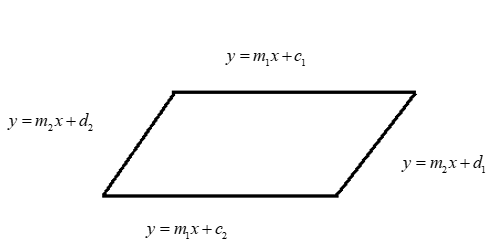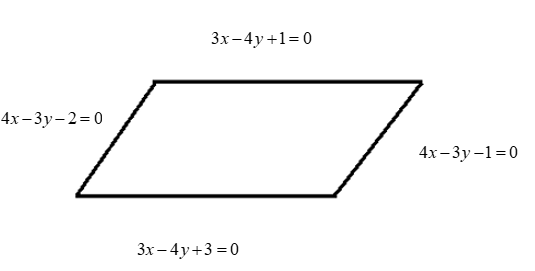
The area of the parallelogram formed by the lines $3x - 4y + 1 = 0$, $3x - 4y + 3 = 0$, $4x - 3y - 1 = 0$ and $4x - 3y - 2 = 0$ is
A. $\dfrac{1}{6}$sq units
B. $\dfrac{2}{7}$sq units
C. $\dfrac{3}{8}$sq units
D. None of the above
Answer
502.2k+ views
Hint: A parallelogram is formed by 4 lines. The area of this parallelogram is given by
$ \Rightarrow $Area of parallelogram$ = \left| {\dfrac{{\left( {{c_1} - {c_2}} \right)\left( {{d_1} - {d_2}} \right)}}{{{m_1} - {m_2}}}} \right|$
So, we need to convert the given equations to a standard slope intercept form that is $y = mx + c$ and then use this formula to find the area of the parallelogram.
Complete step by step answer:
In this question, we are given 4 equations of lines and we are supposed to find the area of the parallelogram formed by these lines.
First of all, let us see the concept of area of parallelogram when 4 equations of lines are given. So, let us draw a parallelogram first.

The above figure is of a parallelogram formed by 4 lines $y = {m_1}x + {c_1}$, $y = {m_1}x + {c_2}$, $y = {m_2}x + {d_1}$ and $y = {m_2}x + {d_2}$. Here, ${m_1}$ and ${m_2}$ are the slopes of the lines. Area of this parallelogram is given by
$ \Rightarrow $Area of parallelogram$ = \left| {\dfrac{{\left( {{c_1} - {c_2}} \right)\left( {{d_1} - {d_2}} \right)}}{{{m_1} - {m_2}}}} \right|$
Now, let us draw a parallelogram for our given equation

Now, we need to convert these equations in the form $y = mx + c$
Equation 1:
$
\Rightarrow 3x - 4y + 1 = 0 \\
\Rightarrow 4y = 3x + 1 \\
\Rightarrow y = \dfrac{3}{4}x + \dfrac{1}{4} \\
$
Hence, ${m_1} = \dfrac{3}{4}$ and ${c_1} = \dfrac{1}{4}$
Equation 2:
$
\Rightarrow 3x - 4y + 3 = 0 \\
\Rightarrow 4y = 3x + 3 \\
\Rightarrow y = \dfrac{3}{4}x + \dfrac{3}{4} \\
$
Hence, ${c_2} = \dfrac{3}{4}$
Equation 3:
$
\Rightarrow 4x - 3y - 1 = 0 \\
\Rightarrow 3y = 4x - 1 \\
\Rightarrow y = \dfrac{4}{3}x - \dfrac{1}{3} \\
$
Hence, ${m_2} = \dfrac{4}{3}$ and ${d_1} = - \dfrac{1}{3}$
Equation 4:
$
\Rightarrow 4x - 3y - 2 = 0 \\
\Rightarrow 3y = 4x - 2 \\
\Rightarrow y = \dfrac{4}{3}x - \dfrac{2}{3} \\
$
Hence, ${d_2} = - \dfrac{2}{3}$
Now, area of parallelogram is given by
$ \Rightarrow $ Area of parallelogram$ = \left| {\dfrac{{\left( {{c_1} - {c_2}} \right)\left( {{d_1} - {d_2}} \right)}}{{{m_1} - {m_2}}}} \right|$
Therefore,
$ \Rightarrow $Area of parallelogram$ = \left| {\dfrac{{\left( {\dfrac{1}{4} - \dfrac{3}{4}} \right)\left( { - \dfrac{1}{3} - \left( { - \dfrac{2}{3}} \right)} \right)}}{{\dfrac{3}{4} - \dfrac{4}{3}}}} \right|$
$
= \left| {\dfrac{{\left( { - \dfrac{2}{4}} \right)\left( { - \dfrac{1}{3} + \dfrac{2}{3}} \right)}}{{\dfrac{{9 - 16}}{{12}}}}} \right| \\
= \left| {\dfrac{{\left( { - \dfrac{1}{2}} \right)\left( {\dfrac{1}{3}} \right)}}{{\dfrac{{ - 7}}{{12}}}}} \right| \\
= \left| {\dfrac{{\dfrac{1}{6}}}{{\dfrac{7}{{12}}}}} \right| \\
= \left| {\dfrac{{1 \times 12}}{{6 \times 7}}} \right| \\
= \left| {\dfrac{2}{7}} \right| \\
= \dfrac{2}{7} \\
$
Hence, the area of parallelogram formed by the lines $3x - 4y + 1 = 0$, $3x - 4y + 3 = 0$, $4x - 3y - 1 = 0$ and $4x - 3y - 2 = 0$ is $\dfrac{2}{7}$sq units.
So, the correct answer is “Option B”.
Note: There are three points in this question that are very important.
The slope of parallel lines is always equal. Therefore, we can see that the slope of lines $3x - 4y + 1 = 0$, $3x - 4y + 3 = 0$ is equal to $\dfrac{3}{4}$.
Second point is that we have taken the formula of area of parallelogram in modulus as the value of area can never be negative.
Third most important point in this question is writing the unit while writing our final answer.
$ \Rightarrow $Area of parallelogram$ = \left| {\dfrac{{\left( {{c_1} - {c_2}} \right)\left( {{d_1} - {d_2}} \right)}}{{{m_1} - {m_2}}}} \right|$
So, we need to convert the given equations to a standard slope intercept form that is $y = mx + c$ and then use this formula to find the area of the parallelogram.
Complete step by step answer:
In this question, we are given 4 equations of lines and we are supposed to find the area of the parallelogram formed by these lines.
First of all, let us see the concept of area of parallelogram when 4 equations of lines are given. So, let us draw a parallelogram first.

The above figure is of a parallelogram formed by 4 lines $y = {m_1}x + {c_1}$, $y = {m_1}x + {c_2}$, $y = {m_2}x + {d_1}$ and $y = {m_2}x + {d_2}$. Here, ${m_1}$ and ${m_2}$ are the slopes of the lines. Area of this parallelogram is given by
$ \Rightarrow $Area of parallelogram$ = \left| {\dfrac{{\left( {{c_1} - {c_2}} \right)\left( {{d_1} - {d_2}} \right)}}{{{m_1} - {m_2}}}} \right|$
Now, let us draw a parallelogram for our given equation

Now, we need to convert these equations in the form $y = mx + c$
Equation 1:
$
\Rightarrow 3x - 4y + 1 = 0 \\
\Rightarrow 4y = 3x + 1 \\
\Rightarrow y = \dfrac{3}{4}x + \dfrac{1}{4} \\
$
Hence, ${m_1} = \dfrac{3}{4}$ and ${c_1} = \dfrac{1}{4}$
Equation 2:
$
\Rightarrow 3x - 4y + 3 = 0 \\
\Rightarrow 4y = 3x + 3 \\
\Rightarrow y = \dfrac{3}{4}x + \dfrac{3}{4} \\
$
Hence, ${c_2} = \dfrac{3}{4}$
Equation 3:
$
\Rightarrow 4x - 3y - 1 = 0 \\
\Rightarrow 3y = 4x - 1 \\
\Rightarrow y = \dfrac{4}{3}x - \dfrac{1}{3} \\
$
Hence, ${m_2} = \dfrac{4}{3}$ and ${d_1} = - \dfrac{1}{3}$
Equation 4:
$
\Rightarrow 4x - 3y - 2 = 0 \\
\Rightarrow 3y = 4x - 2 \\
\Rightarrow y = \dfrac{4}{3}x - \dfrac{2}{3} \\
$
Hence, ${d_2} = - \dfrac{2}{3}$
Now, area of parallelogram is given by
$ \Rightarrow $ Area of parallelogram$ = \left| {\dfrac{{\left( {{c_1} - {c_2}} \right)\left( {{d_1} - {d_2}} \right)}}{{{m_1} - {m_2}}}} \right|$
Therefore,
$ \Rightarrow $Area of parallelogram$ = \left| {\dfrac{{\left( {\dfrac{1}{4} - \dfrac{3}{4}} \right)\left( { - \dfrac{1}{3} - \left( { - \dfrac{2}{3}} \right)} \right)}}{{\dfrac{3}{4} - \dfrac{4}{3}}}} \right|$
$
= \left| {\dfrac{{\left( { - \dfrac{2}{4}} \right)\left( { - \dfrac{1}{3} + \dfrac{2}{3}} \right)}}{{\dfrac{{9 - 16}}{{12}}}}} \right| \\
= \left| {\dfrac{{\left( { - \dfrac{1}{2}} \right)\left( {\dfrac{1}{3}} \right)}}{{\dfrac{{ - 7}}{{12}}}}} \right| \\
= \left| {\dfrac{{\dfrac{1}{6}}}{{\dfrac{7}{{12}}}}} \right| \\
= \left| {\dfrac{{1 \times 12}}{{6 \times 7}}} \right| \\
= \left| {\dfrac{2}{7}} \right| \\
= \dfrac{2}{7} \\
$
Hence, the area of parallelogram formed by the lines $3x - 4y + 1 = 0$, $3x - 4y + 3 = 0$, $4x - 3y - 1 = 0$ and $4x - 3y - 2 = 0$ is $\dfrac{2}{7}$sq units.
So, the correct answer is “Option B”.
Note: There are three points in this question that are very important.
The slope of parallel lines is always equal. Therefore, we can see that the slope of lines $3x - 4y + 1 = 0$, $3x - 4y + 3 = 0$ is equal to $\dfrac{3}{4}$.
Second point is that we have taken the formula of area of parallelogram in modulus as the value of area can never be negative.
Third most important point in this question is writing the unit while writing our final answer.
Recently Updated Pages
Master Class 11 Economics: Engaging Questions & Answers for Success

Master Class 11 English: Engaging Questions & Answers for Success

Master Class 11 Social Science: Engaging Questions & Answers for Success

Master Class 11 Biology: Engaging Questions & Answers for Success

Class 11 Question and Answer - Your Ultimate Solutions Guide

Master Class 11 Business Studies: Engaging Questions & Answers for Success

Trending doubts
10 examples of friction in our daily life

One Metric ton is equal to kg A 10000 B 1000 C 100 class 11 physics CBSE

Difference Between Prokaryotic Cells and Eukaryotic Cells

1 Quintal is equal to a 110 kg b 10 kg c 100kg d 1000 class 11 physics CBSE

Explain zero factorial class 11 maths CBSE

What is a periderm How does periderm formation take class 11 biology CBSE




